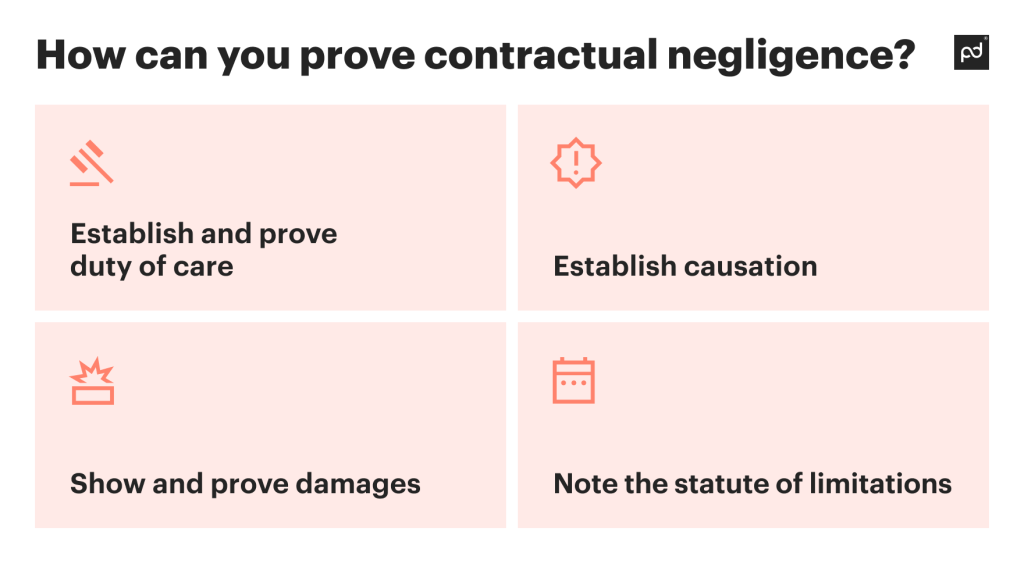When you abdicate your contractual obligations, and it leads to damages or losses, you are guilty of contractual negligence.
In most cases, neglecting a contractual provision could result in a fine being imposed. For serious acts of reckless disregard, it could land you in jail.
In this article, we’ll help you understand contractual negligence and why it is something worth losing sleep over.
Key takeaways
- Contractual negligence involves abandoning your duty of care to other parties to a contract, including third parties.
- If a court finds you or your business guilty of negligence, all responsible parties could face fines, license termination, or even jail time.
- Having professional liability insurance and a liability waiver can help reduce the cost of contract negligence to your business.
What is contract negligence?
Contractual negligence is the act of abandoning your contractual duties, which then results in injury or damages to other parties to the agreement.
It sounds similar to a breach of contract, but there is a slight difference.
According to US contract law, negligence falls under the rule of tort, which states that any wrongdoing protected under the contract is a civil suit.
In essence, the party at fault has to pay punitive damages for injuries, deaths, medical bills, and other forms of loss resulting from the negligence of contractual relationships.
How can you prove contractual negligence?
Contract negligence is easy to prove once there are visible damages resulting from the lack of an acceptable standard of care.
However, each case has to fulfill a series of conditions to meet the threshold for negligence of contract, whether criminal or gross negligence.
So, to prove contract negligence, you have to do the following:

Establish and prove duty of care
The aggrieved party has to prove that the accused has a legal duty of care under the contractual obligations.
For example, a construction firm responsible for erecting a new office tower is legally obligated to ensure that the new building is safe to inhabit once completed.
Establish causation
The aggrieved also has to prove that the cause of the damages stems from the accused’s dereliction of responsibility, especially in cases of gross misconduct or willful negligence.
Likewise, if the same hypothetical building collapses as a result of poor construction practices, our example company in charge of building the structure will have to pay damages for contract negligence.
Show and prove damages
To claim damages for contract negligence, you have to prove that damages were unavoidable had it not been for the accused neglecting their duty of care.
The damage could fall under the following:
- Physical (injuries, medical conditions, wrongful death, etc.)
- Financial (damage to property, economic loss of assets, service disruption, etc.).
Note the statute of limitations
Claimants should always file their suit for damages within the statute of limitations. Otherwise, they risk relinquishing their rights to legal compensation.
For instance, the statute of limitations for negligence of contract in California and Florida is two years.
However, if the claimant is a minor, the statute of limitations only kicks in after they turn 18. There are also special considerations for people with diminished mental capacity.
Real-world examples of contractual negligence
Here are a few famous contract negligence examples that resulted in different levels of damages.
Wrongful death
The widow of an F-16 pilot sued a government contractor, PAE Aviation Technical Services, for wrongful death resulting from a faulty hydraulic system in the aircraft.
Psychological trauma
Riders stuck on a rollercoaster for hours sued Six Flags Magic Mountain for emotional distress and physical injuries.
Physical injury
The owner of a building in New York had to pay $7 million in damages after a worker fell down the elevator shaft.
Damage to property
When James Street Hardware was implicated in causing a fire that set Spizziri’s building on fire, the Supreme Court ordered James Street to pay for the partial reconstruction of the building.
Financial damages
Triple Point Technology, Inc (software development company) had to pay compensation to PTT Public Company Limited (a Thai petrochemical company) for negligence, leading to significant financial losses.
Why is contractual negligence a big deal?
Contractual negligence should be taken seriously because of the potential harm to victims.
Say you are a contractor working on airplane maintenance; the potential consequences of your gross negligence could lead to multiple deaths.
Other negative impacts of contract negligence on victims include permanent disability, financial losses, alterations in genetic disposition, emotional distress, and a myriad of other conditions.
As for your business, being involved in negligence cases can ruin your reputation. After a series of bad PR events, United Airlines has now become a meme.
Likewise, the image of the Boeing 737 MAX will forever be tarnished following several high-profile mishaps, including the bizarre case of a door opening mid-flight.
As a consequence, some airlines have completely pulled this particular Boeing model from their fleet, which has led to the tanking of stocks.
Undoubtedly, corporate heads will roll, lawsuits will follow, as well as fines from regulators.
Is breach of contract the same as negligence?
In everyday speech, breach of contract and negligence are used interchangeably. Although there are some overlapping features, both are categorized differently in US law.
As mentioned earlier, negligence falls under the law of tort, which refers to the wrongdoing done to an individual or business entity. A contract doesn’t have to exist between the accused and the aggrieved (third) party.
The elements of contractual negligence include:
- Breaching of duty of care
- Taking an action that leads to damages.
- Not taking action which leads to damages.
For instance, if a shopper slips and breaks their hip on a wet floor at Walmart, the shop could face a negligence claim despite not being in a legally binding contract with the injured shopper.
Breach of contract claims fall under contract law, which means that a legally binding contract has to exist between the two parties involved.
The conditions needed to prove a breach of contract claim include:
- The aggrieved and the breaching party must have a binding contract.
- The aggrieved can prove that the breaching party failed to abide by the terms of the agreement.
- The breach resulted in provable physical and physiological damages to the aggrieved.
Due to the close connection between both terms, some offenses meet the criteria for tortious negligence and breach of contract.
In such cases, as in the previously referenced Triple Point Technology, Inc vs. PTT Public Company Limited, the court has to define the parameters and place a cap on the compensation.
How to avoid and deal with contract negligence
Most cases of contract negligence occur because someone in an organization failed to exercise reasonable care.
Sometimes, it is a freak accident; other times, it is avoidable.
Here are some tips to avoid breach of contract negligence and mitigate the fallout when it occurs.
- Get professional liability insurance. Also known as errors and omissions insurance, this insurance package helps businesses handle claims and settlements for malpractice, professional negligence, and other wrongdoings under the tort of negligence.
- Use a liability waiver. Although a liability waiver is not a blanket cover for all forms of negligence, it could provide a limitation of liability and legal culpability when damages occur.
- Apply due diligence to every aspect of the business. If the Boeing engineers and their contractors applied due diligence in quality control, their planes wouldn’t be malfunctioning at this frequency.
- Establish a communication plan to address all potential risk factors with employees as well as customers. This includes using “slippery floor” and “do not touch” signs according to OSHA regulations.
- Conduct regular site and equipment inspections to make sure everything is in tip-top shape.
- Consult a law firm for legal advice to explore your options under tort and contract law whenever a crisis arises. Your business lawyers can also determine if the offense is still within the contractual term or beyond the statute of limitations.
- Work on a crisis response plan for cases of malpractice and negligent torts. Don’t come out combative and defensive — you might end up digging your company’s reputation into a deeper hole than United Airlines.
Keep track of your contracts with PandaDoc
Negligence in contract law refers to wrongful acts that lead to bodily harm or damage to property.
It can also be escalated to a negligent breach of contract if you are in a legal agreement with the aggrieved party.
Apart from physical damages, negligence can tarnish your company’s reputation and open a can of legal worms filled with fines, settlements, and eventual bankruptcy.
With a platform like PandaDoc, you can track and review your contracts and business document templates to ensure the guidelines are up to date.
The online document repository also contains liability waivers and other exculpatory documentation.
This could be your last lifeline when dealing with negligence claims, and the prospect of massive settlements from class action suits.
To start using PandaDoc for contract management, book a quick demo right away.
Disclaimer
PandaDoc is not a law firm, or a substitute for an attorney or law firm. This page is not intended to and does not provide legal advice. Should you have legal questions on the validity of e-signatures or digital signatures and the enforceability thereof, please consult with an attorney or law firm. Use of PandaDoc services are governed by our Terms of Use and Privacy Policy.


